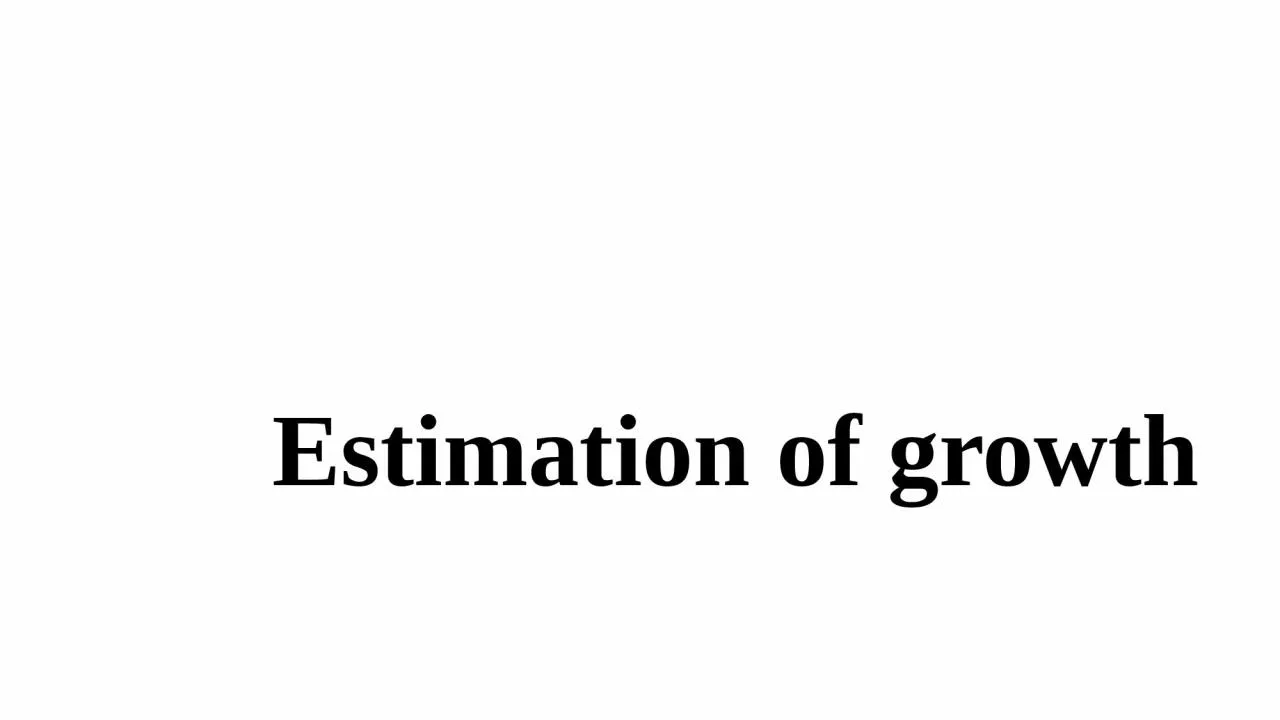

Therefore all stock assessment methods in fisheries work essentially with the age composition data Individual growth mode1 Growth in length can be modeled in a number of ways The model most frequently used in fisheries was developed by von Bertalanffy 1957 The growth equation is referred a ID: 1026398
Download Presentation The PPT/PDF document "Estimation of growth The study of growth..." is the property of its rightful owner. Permission is granted to download and print the materials on this web site for personal, non-commercial use only, and to display it on your personal computer provided you do not modify the materials and that you retain all copyright notices contained in the materials. By downloading content from our website, you accept the terms of this agreement.
1. Estimation of growth
2.
3. The study of growth means the determination of the body size as a function of age. Therefore, all stock assessment methods in fisheries work essentially with the age composition data.
4. Individual growth mode1Growth in length can be modeled in a number of ways. The model most frequently used in fisheries was developed by von Bertalanffy (1957). The growth equation is referred as von-Bertalanffy’s equation (VBGF).Lt = L [ 1 – e –K(t – to)] Where, Lt = length of the fish at time ‘t’ L = asymptotic length. – this is the theoretical length beyond which fish does not grow. K = catabolic growth coefficient –rate at which length approaches L t = Age of the fish. t0 = Theoretical age at which length of the fish would have been zero.In the above equation L , K and t0 are called growth parameters.
5. Methods for estimating growth parametersFord – Walford Method This is a simplest method of estimating the growth parameters for the length data representing equal time intervals. This method is widely applied as the plot could be used to obtain a quick estimate of L and K without calculation also. From the von Bertalanffy’s growth equation it follows a series of algebraic manipulations.Where, a = L∞ * (1-b) and b = exp (-K * Δt) K = - lnb; L∞ = (a /(1- b))L (t + Δt) = a + b*L(t)X = L(t) Y = L (t + Δt)
6. Draw graph using Lt and Lt+1 as ‘X’ and ‘Y’ values respectively and draw a line connecting maximum points (at least three points must be on the straight line).Draw another straight line from the origin at 45° till it meets the first straight line.Mark the point where two lines cross each other and draw a perpendicular to X – axis.Mark L on X – axis.Draw a right triangle on the first straight line and measure tan which gives ‘b’ value.Substitute the ‘b’ value in the equation K = -ln b and estimate ‘K’.
7. Chapman’s method: Chapman (1961) and later Gulland (1969) is again based on constant pairs of intervals. From von Bertalanffy’s growth equation is implies that L (t + Δt) – Lt = C * L∞ - C*L(t)Since K and L∞ are constants, if Δt remain constant and it becomes a linear equation i.e. y = a + bx Where, a = C* L∞ and b = - C C = 1 – exp (-K *Δt) X = L(t) Y = L (t +Δt) – L(t) K = - (1/Δt)*ln(1+b) L∞ = - a/b or a/c
8. Draw graph using L(t) as ‘X’ and L (t +Δt) – L(t) as ‘Y’ values.The downward slope that touches on X – axis indicates L.Draw a right triangle on the slope and mark angle. Tan will gives ‘b’ value.Substitute ‘b’ value in the formula K = - (1/Δt)* In ( 1 + b) and estimate ‘K’
9. Gulland and Holt methodThis method is also used for estimating L and K growth parameters. This method is mainly used while dealing with data of variable time intervals between samples. X=Lt = L(t+1) + Lt / 2 Y = ΔL/Δt = [L(t+Δt) – Lt] /[(t+Δt) –t]L = - a/b K = -ba = K*L and b = -K
10. The intersection point between the regression line and the X-axis gives L ∞ .Draw graph using above ‘X’ and ‘Y’ values.Downward slope touching X – axis indicates L.Draw right angle triangle on the slope and mark angle.Substitute tan in the formula K = -b and estimate ‘K’.
11. The von Bertalanffy’s plotIt can be used to estimate K and to from age/length data which requires the equation to be rewritten as -ln (1 – Lt/L∞) = - K * to + K*tWhere ‘t’ is the independent variable and the left hand side of the equation as dependent variable, i.e. X=t and Y= -ln (1 – Lt/L∞) slope b = K and intercept a = - K * to K = b t0 = -a/b
12. Draw graph using above ‘X’ and ‘Y’ values.Upward slope, which crosses on X – axis indicates ‘t0’ value.Draw a right angle triangle on the slope and mark angle.Substitute tan in formula K = b.
13.